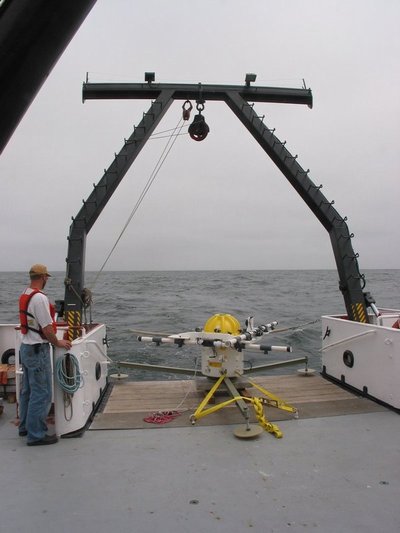August 29, 2006
Coastal ocean observatory extends miles up Columbia River
The Columbia River is the source of three quarters of the water pouring into the Pacific Ocean from the West Coast. Scientists with a just-announced $19 million grant are poised to develop new technologies and infrastructures to monitor changes in the river below Bonneville Dam and predict how they affect wide swaths of ocean.
The Columbia, with some of its fresh water at times going north into the Strait of Juan de Fuca and as far south as San Francisco Bay, can affect everything from nutrient levels in coastal estuaries and bays to swirling eddies miles wide off the coast that young fish seem to favor.
How such things as climate change and a growing concentration of human activities along the river can affect ocean waters needs to be better understood, according to the National Science Foundation, which is funding its first ever science and technology center focused on coastal margins and the ocean.
Science and Technology Center for Coastal Margin Observation and Prediction
- Will study “coastal margins,” which include rivers that flow to the sea, coastal areas with bays and estuaries and the shores along such waterways that are home to both natural ecosystems and human activities.
- Will develop what has been nicknamed SATURN, a river-to-ocean observatory that relies on networks of riverbed and seafloor sensors, mobile platforms, and instruments and unmanned vehicles in the water that are all able to communicate with each other and scientists.
- Will build on work already underway by Oregon Health & Science University’s Antonio Baptista, the principal investigator, and researchers at partner academic institutions University of Washington and Oregon State University. (See Oregon Health & Science University’s press release at http://www.stccmop.org/node/59.)
UW’s Applied Physics Laboratory helping develop infrastructure and instruments
- UW’s Applied Physics Laboratory will be taking up SATURN’s infrastructure challenges of supplying power to instruments and communicating with instruments to obtain data and direct research. In addition, UW researchers and engineers will help develop underwater vehicles, miniaturize airborne ocean sensors and deploy new kinds of sensor networks, according to David Martin, an APL associate director and a co-principal investigator for the Science and Technology Center for Coastal Margin Observation and Prediction.
- “We need to be able to profile the whole water column across broad spatial areas to understand its physical, biological, sedimentary and chemical structure so we can begin to compare how things change when something like an El Niño is underway,” Martin says.
- Other UW researchers will provide expertise about Columbia River microorganisms, estuary conditions and the Pacific Ocean.
Emerging national initiatives on ocean observing systems
- There is growing interest and funding for long-term, continuous ocean-observation systems. In the United States, the National Science Foundation has mounted an Ocean Observatories Initiative (see http://www.orionprogram.org/OOI/default.html).
- Although not a part of the U.S. Ocean Observation Initiative, SATURN will dovetail with other ocean observing efforts, Martin says. Researchers with the new center, for instance, will collaborate with U.S. and Canadian organizers of the seafloor NEPTUNE project (http://www.neptune.washington.edu/) and with Canadians operating the near-shore observatory called VENUS (http://www.venus.uvic.ca/).
NSF funds 17 science and technology centers around nation since 1999, including four this year
- NSF’s only other science and technology center in the Pacific Northwest is the Science and Technology Center on Materials and Devices for Information Technology Research, based at the UW, that focuses on photonic materials.
###
For more information on UW’s role:
Martin, (206) 543-2945, dmartin@apl.washington.edu



